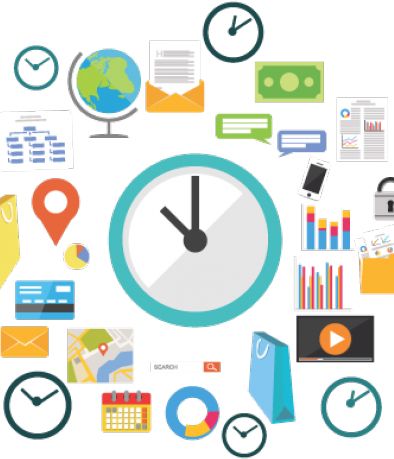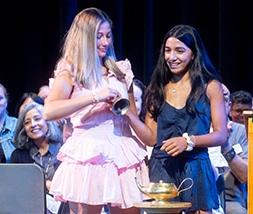Over the past month, I have been wondering which is more difficult: having too much to do or not having enough to do. For some people, work may now seem “endless.” The lines blur between academic work and personal time because we are doing both in the same space. Some parents of younger students may feel that their daughters have too much homework to manage independently, while others would prefer more synchronous classes and more homework to provide more structure to the day. Not surprisingly, the answer to the question of which is more difficult–having too much to do or not having enough–is, “It depends.”
When students are in school, the academic day is packed full of classes and activities, followed by more activities and homework after school until they go to bed (too late) and wake up and do it all over again. One of the benefits to come out of this dilemma is that we get to slow down and think. One of the challenges is that we might slow down too much and overthink. Sometimes, when students have a long stretch of time–one-three hours or more–they may lose momentum.
Knowing now that we will continue with distance learning until the end of this school year, this is a good time to press pause and talk about what is working and what adjustments might need to be made. A daily routine helps to establish mutual expectations, minimize conflict, and reduce uncertainty. At the same time, it is equally important to be flexible as needs and circumstances change. If everything seems to be going as smoothly as it can for now, that is worth celebrating! If there are adjustments to be made, this is a great time to try out some new ideas.
When we are in school, we often focus on the nuts and bolts and logistics of learning such as planners and calendars for time management and folders and binders for organization. Last Saturday, I attended a video conference entitled ‘All Learning is Social and Emotional’, and it got me thinking that changes in our normal academic routines may need a different framework for planning. I thought I would tell you about two “ungendas” that may set the tone for a day of learning at home, and offer a few of my favorite tools, or “nuts and bolts,” that may also be helpful.
Open Agenda
The first framework is something of an open agenda (for when your daughter says she has too much time on her hands). If this sounds familiar, it might be helpful to remember that sometimes, structure does not have to be academic. For example, a friend of mine who home-schooled her two boys posted what they called their “Everyday To-Do List” which read:
Everyday find…
Something creative
Something active
Something hard/difficult
Something helpful to others
Something joyful
Something to read.
The boys chose these activities each day, with no guidance other than these broad categories, and they had to document them and debrief at the end of the day. If this seems too open-ended, keep in mind that cognitive flexibility and self directed learning are extremely valuable and important skills and, everything we know about the science of learning guides us to shorter bursts of interest-driven, experiential learning with active breaks in between.
Way to Frame the Day
When every day seems to blend into the next, it can be especially grounding to set the intention for the day, press pause to process, and reflect on what went well and what was challenging. The Collaboration for Academic, Social and Emotional Learning (CASEL) calls these “Signature Practices.” These routines are most often used in the classroom, but they also offer useful touch points as a kind of “outline for the day” when students are learning at home. The day begins with an “Optimistic Opener” which could be a warm greeting and a hug, a meditation, a walk or some other way to check in. Mid-day, students take a “Brain Break” which is important because too often, we take breaks for granted or rush through lunch when we need to be prioritizing nourishment for our bodies and our brains. In the evening, a “Reflection Roundup” is a moment to think about highlights, when you were at your best, when you might have felt unrest, and what you might do to improve tomorrow. According to the Social Emotional Learning Framework, these signature practices can help students feel connected to the work ahead, anchor their learning, and provide a sense of accomplishment at the end of the day.
Signature Practices set the tone for the day while the Everyday To-Do List engages students’ imaginations to entertain and perhaps explore new hobbies and interests that they may not have had time for during the regular school week.
Winsor students and their families are already pretty tech savvy and resourceful, and you are well aware that there is a veritable sea of useful digitial options for planning and organization. But for the pragmatic parents, I thought I would close by sharing a few of the digital tools I have been exploring to help make distance learning more accessible to all learners.
(A Few of My Favorite Things)
Google Calendar
-
Students’ schedules are already populated on the calendar
-
Uncluttered one hour time blocks
-
Color coding!
-
Easy to toggle back and forth between a day and week
-
Notifications to remind students that it is time to do an assignment
-
Easy to share with advisors and/or parents
Chrome Extensions for Accessibility
Digital Reader
Habit Trackers
There is an abundance of research that shows that the best way to maintain, break, or start new habits is by keeping track of them. We know that humans are creatures of habit and adolescent brains are especially primed to develop healthy ones. Aristotle cannot have been wrong when he said, “We are what we repeatedly do. Excellence, then, is not an act, but a habit.”
When the world has been turned upside down, practical tools for planning combined with an “ungenda” to support our wellbeing, may provide a sense of balance that we need right now.
I am happy to answer questions, listen to your concerns, and share ideas for ways we can support student learning, so please don’t hestitate to contact me at
lvantine@winsor.edu.






